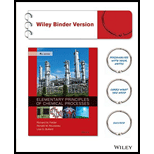
8.1. The specific internal energy of formaldehyde (HCHO) vapor at 1 atm and moderate temperatures is given by the formula
where T is in °C.
Calculate the specific internal energies of formaldehyde vapor at 0°C and 200°C. What reference temperature was used to generate the given expression for
- ?
- The value of U calculated for 200°C is not the true value of the specific internal energy of formaldehyde vapor at this condition. Why not? (Him: Refer back to Section 7.5a.) Briefly state the physical significance of the calculated quantity.
- Use the closed system energy balance to calculate the heat (J) required to raise the temperature of 3.0 mol HCHO at constant volume from 0°C to 200°C. List all of your assumptions. From the definition of heat capacity at constant volume, derive a formula for
Then use this formula and Equation 8.3-6 to calculate the heat (J) required to raise the temperature of 3.0 mol of HCHO(v) at constant volume from 0°C to 200°C. [You should get the same result you got in Part (c).]
(a)
Interpretation:
The specific internal energies of formaldehyde vapor and the temperature should be calculated.
Concept introduction:
In the thermodynamic closed system, the exchange of matter does not take place but heat can be exchanged and thus, the work done by the system is considered to be zero.
The specific internal energy of formaldehyde Vapor is given by:
Where T= temperature of formaldehyde
Answer to Problem 8.1P
Explanation of Solution
Calculate the internal energy of formaldehyde at 0 and 200° C as,
Since the reference temperature is that temperature at which internal energy becomes zero.
The reference temperature is
(b)
Interpretation:
The importance of calculated quantity should be explained.
Concept introduction:
Thermodynamic closed system in which no exchange of matter takes place but the exchange of heat occurs then the work done by the system is considered to be zero.
The specific internal energy of formaldehyde Vapor is given by:
Where T= temperature of formaldehyde
Explanation of Solution
The calculation of the absolute value of internal energy for a process material is not possible. However, it is possible to estimate the change in internal energy for a defined change of state like solid, liquid or gas.
In part (a) calculation, the change in internal energy is calculated with references to 0 °C.
(c)
Interpretation:
The heat required to raise the temperature for the given range by stating the assumptions should be calculated.
Concept introduction:
Thermodynamic closed system in which no exchange of matter takes place, but the exchange of heat occurs then the work done by the system is zero.
The specific internal energy of formaldehyde Vapor is given by:
Where T= temperature of formaldehyde
Answer to Problem 8.1P
- Work done by the system is zero.
- Potential energy drop is zero.
- Kinetic energy drop is also 0.
- No moving parts in the system.
- There is no energy transfer to and from the system
Explanation of Solution
From total energy balance,
Since the kinetic energy, potential energy and the work done are zero.
Using part (a),
Therefore, total energy for the system is,
Assumptions.
- Work done by the system is zero.
- Potential energy drop is zero.
- Kinetic energy drop is also 0.
- No moving parts in the system.
- There is no energy transfer to and from the system
(d)
Interpretation:
A formula for Cv should be derived and it should be used to calculate the heat required for the given case.
Concept introduction:
Thermodynamic closed system in which no exchange of matter takes place, but the exchange of heat occurs then the work done by the system is zero.
The specific internal energy of formaldehyde Vapor is given by:
Where T= temperature of formaldehyde
Answer to Problem 8.1P
Explanation of Solution
Use the given equation,
Differentiate both sides,
Rearranging the above equation,
At constant volume,
Apply the given values as,
Differentiate the equation as,
Finally, calculate the change of moles for the given case as,
Want to see more full solutions like this?
Chapter 8 Solutions
Elementary Principles of Chemical Processes, Binder Ready Version
Additional Engineering Textbook Solutions
Elements of Chemical Reaction Engineering (5th Edition) (Prentice Hall International Series in the Physical and Chemical Engineering Sciences)
Process Dynamics and Control, 4e
Java: An Introduction to Problem Solving and Programming (8th Edition)
Database Concepts (7th Edition)
Starting Out with Java: From Control Structures through Objects (6th Edition)
Artificial Intelligence: A Modern Approach
 Introduction to Chemical Engineering Thermodynami...Chemical EngineeringISBN:9781259696527Author:J.M. Smith Termodinamica en ingenieria quimica, Hendrick C Van Ness, Michael Abbott, Mark SwihartPublisher:McGraw-Hill Education
Introduction to Chemical Engineering Thermodynami...Chemical EngineeringISBN:9781259696527Author:J.M. Smith Termodinamica en ingenieria quimica, Hendrick C Van Ness, Michael Abbott, Mark SwihartPublisher:McGraw-Hill Education Elementary Principles of Chemical Processes, Bind...Chemical EngineeringISBN:9781118431221Author:Richard M. Felder, Ronald W. Rousseau, Lisa G. BullardPublisher:WILEY
Elementary Principles of Chemical Processes, Bind...Chemical EngineeringISBN:9781118431221Author:Richard M. Felder, Ronald W. Rousseau, Lisa G. BullardPublisher:WILEY Elements of Chemical Reaction Engineering (5th Ed...Chemical EngineeringISBN:9780133887518Author:H. Scott FoglerPublisher:Prentice Hall
Elements of Chemical Reaction Engineering (5th Ed...Chemical EngineeringISBN:9780133887518Author:H. Scott FoglerPublisher:Prentice Hall
 Industrial Plastics: Theory and ApplicationsChemical EngineeringISBN:9781285061238Author:Lokensgard, ErikPublisher:Delmar Cengage Learning
Industrial Plastics: Theory and ApplicationsChemical EngineeringISBN:9781285061238Author:Lokensgard, ErikPublisher:Delmar Cengage Learning Unit Operations of Chemical EngineeringChemical EngineeringISBN:9780072848236Author:Warren McCabe, Julian C. Smith, Peter HarriottPublisher:McGraw-Hill Companies, The
Unit Operations of Chemical EngineeringChemical EngineeringISBN:9780072848236Author:Warren McCabe, Julian C. Smith, Peter HarriottPublisher:McGraw-Hill Companies, The





